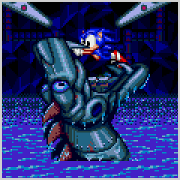|
Phantasium posted:I press the power button on my brand new NX and oh my god, what is that, is that what I think... it is! It's R.O.B., it's just transformed into R.O.B. my robotic operating buddy, he's sliding out of my entertainment center and he's following me around and I can finally play Gyromite NX by walking him around my neighborhood, and his laser cannon will take out the bullies at school, it is amazing, god bless Nintendo! loving nailed it.
|
|
|
|

|
| # ? May 10, 2024 20:13 |
|
wicka posted:but it doesn't have a negative impact, because normal people implicitly understand that it's not accurate footage and doesn't represent how the game actually looks You might find it surprising, but abnormal people exist. Some of them play video games.
|
|
|
|
Guy Goodbody posted:If you don't know much about how commercials are made and you see the Switch ad, I can understand being concerned that the poor frame rate on the portable screen in Zelda would be worrying. But once you understand that there was nothing on the screen when it filmed, it was just a prop and the footage was added later by computers, that should be the end of the discussion Neurotypicals are just curious why they'd use choppy footage in their hardware reveal. The fanboys keep the topic going by repeatedly posting hyperbolic bewilderment over the fact people are posting about it, like it's some forbidden incarnation of the Old Ones rather than just people wondering about the hardware performance. The world won't end if you let people notice things and comment on them.
|
|
|
|
Toady posted:Neurotypicals are just curious why they'd use choppy footage in their hardware reveal. The fanboys keep the topic going by repeatedly posting hyperbolic bewilderment over the fact people are posting about it, like it's some forbidden incarnation of the Old Ones rather than just people wondering about the hardware performance. Nuh uh, you're the crazy ones! It seems like this argument has reached an impasse
|
|
|
|
2015–present: Mobile and Nintendo Switch On 17 March 2015, Nintendo announced a partnership with Japanese mobile developer DeNA to produce games for smart devices.[50][51] The first of these, Miitomo, was released in March 2016.[52] On the same day, Nintendo announced a new "dedicated games platform with a brand new concept" with the codename "NX" that would be further revealed in 2016.[51][53] Reggie Fils-Aimé, president of Nintendo of America, referred to NX as "our next home console" in a June 2015 interview with The Wall Street Journal.[54] In a later 16 October 2015 article, The Wall Street Journal relayed speculation from unnamed inside sources that, although unknown, the NX was intended to feature "industry leading" hardware specifications and be usable as both a home and portable console. It was also reported that Nintendo had begun distributing software development kits (SDKs) for NX to third-party developers, with the unnamed source further speculating that these moves "[suggest that] the company is on track to introduce [NX] as early as [2016]."[55] At an investor's meeting on 27 April 2016, Nintendo announced that the NX would be released worldwide in March 2017.[56] In an interview with Asahi Shimbun in May 2016, Kimishima stated that the NX was a new concept that would not succeed the 3DS or Wii U product lines.[57] At a shareholders' meeting following E3 2016, Shigeru Miyamoto stated that the company chose not to present Nintendo NX during the conference due to concerns that competitors could copy from it if they revealed it too soon.[58] The same day, Kimishima also revealed during a Q&A session with investors that they were also researching virtual reality.[59] In May 2015, Universal Parks & Resorts announced that it was partnering with Nintendo to create attractions at Universal Parks based upon Nintendo properties.[60] The following year Nintendo also expressed a desire to enter the animated film market.[61] In July 2016, the company announced it was bringing back the NES in the form of the NES Classic Edition (called Nintendo Classic Mini in Europe). The plug-and-play console will support HDMI, two-player modes, and have a controller similar to the original NES controller. The controller will also be able to connect to a Wii Remote for use with Wii and Wii U Virtual Console titles. The NES Classic Edition will come with 30 games pre-installed, including Final Fantasy, Kid Icarus, The Legend of Zelda, Zelda II: The Adventure of Link, and Dr. Mario, among others. It will be released in November 2016. Additional controllers will also be available.[62] The July 2016 release of the Pokémon Go mobile app by Niantic caused shares in Nintendo to double, due to investor misunderstanding that the software was the property of Nintendo. Later that month, Nintendo released a statement clarifying its relation with Niantic, Nintendo stated it owned 32% of Pokémon intellectual property owner The Pokémon Company, and though it would receive some licensing and other revenues from the game it expected the impact on Nintendo's total income to be limited. As a result of the statement Nintendo's share price fell substantially, losing 17% in one day of trading.[63][64] After a reduction in shareprice from the Pokémon Go peak, the company was still valued at over 100 times its net income, a price–earnings ratio greatly exceeding the average on the Nikkei 225.[65] Analysts speaking to Bloomberg L.P. and the Financial Times both commented on the potential future value of Nintendo's IP if transferred to the mobile phone game business.[65][66] In August 2016, Nintendo of America sold 90% of its controlling stake (55%) in the Seattle Mariners to a group of investors led by mobile phone businessman John Stanton for $640 million.[9][67] After the announcement of the mobile game Super Mario Run in September 2016, Nintendo's stock soared to just under its recent high point after the release and success of Pokémon Go earlier in the year, something noted by journalists as even more significant than Pokémon Go, as Super Mario Run was developed in-house by Nintendo, which was not the case with Pokémon Go.[68] On October 20, 2016, Nintendo released a preview trailer about the NX, revealing the official name to be the Nintendo Switch.[69] According to Reggie Fils-Aime, the console gives game developers new abilities to bring their creative concepts to life by opening up the concept of gaming without limits.[70]
|
|
|
|
does it cheevos or trophies because no buys if not
|
|
|
|
InFlames235 posted:I mean if the X1 is on par with the 360 & PS3, the X2 is considered more-so on par with the PS4 and Xbone. Am I saying it's exact? Of course not, but it's probably a few times faster than the Wii U which makes it close enough. Also, pascal architecture is known for its efficiency and as some people were saying even the shield is about 8 hours of battery life on an X1 Pascal based customized TegraX2. 1.5tflops. It's a custom version of Parker. Battery life is 3 hours currently on the handheld. Before the final build spec ships to manufacturing in November, the hope is to get it up to 5. Utnayan fucked around with this message at 20:09 on Oct 20, 2016 |
|
|
|
Lol at the framerate argument, gently caress you people are nuts.
|
|
|
|
Guy Goodbody posted:Nuh uh, you're the crazy ones! You are nuts if it bothers you so much that people are commenting about the footage in the trailer, like the very topic is verboten and you're baffled anyone is discussing it.
|
|
|
|
Guy Goodbody posted:But now that you understand how the ad was made, it didn't have a negative impact on you, right? Right, but other people exist other than myself that may not realize that at this time and not want to buy the console. Personally, I don't see myself using the mobile aspect much, and the games that they'll have at launch looks loving fantastic. Switch will ruin me.
|
|
|
|
Frame rate, also known as frame frequency, is the frequency (rate) at which an imaging device displays consecutive images called frames. The term applies equally to film and video cameras, computer graphics, and motion capture systems. Frame rate is usually expressed in frames per second (FPS). Frame rate and human vision[edit] Further information: Motion perception The temporal sensitivity and resolution of human vision varies depending on the type and characteristics of visual stimulus, and it differs between individuals. The human visual system can theoretically process 1000 separate images per second but is not noticeable to the untrained eye after about 150 and up to around 240 where motion looks realistic.[1] Modulated light (such as a computer display) is perceived as stable by the majority of participants in studies when the rate is higher than 50 Hz through 90 Hz. This perception of modulated light as steady is known as the flicker fusion threshold. However, when the modulated light is non-uniform and contains an image, the flicker fusion threshold can be much higher.[2] With regard to image recognition, people have been found to recognize a specific image in an unbroken series of different images, each of which lasts as little as 13 milliseconds.[3] Persistence of vision sometimes accounts for very short single-millisecond visual stimulus having a perceived duration of between 100 ms and 400 ms. Multiple stimuli that are very short are sometimes perceived as a single stimulus, such as a 10 ms green flash of light immediately followed by a 10 ms red flash of light perceived as a single yellow flash of light.[4] Film[edit] Silent films[edit] Early silent films had stated frame rates anywhere from 16 to 24 frames per second (FPS),[5] but since the cameras were hand-cranked, the rate often changed during the scene to fit the mood. Projectionists could also change the frame rate in the theater by adjusting a rheostat controlling the voltage powering the film-carrying mechanism in the projector.[6] Silent films were often intended to be shown at higher frame rates than those used during filming.[7] These frame rates were enough for the sense of motion, but it was perceived as jerky motion. By using projectors with dual- and triple-blade shutters, the rate was multiplied two or three times as seen by the audience. Thomas Edison said that 46 frames per second was the minimum needed by the visual cortex: "Anything less will strain the eye."[8][9] In the mid to late 1920s, the frame rate for silent films increased to between 20 and 26 FPS.[8] Sound films[edit] When sound film was introduced in 1926, variations in film speed were no longer tolerated as the human ear is more sensitive to changes in audio frequency. Many theaters had shown silent films at 22 to 26 FPS which is why 24 FPS was chosen for sound. From 1927 to 1930, as various studios updated equipment, the rate of 24 FPS became standard for 35 mm sound film.[1] At 24 FPS the film travels through the projector at a rate of 456 millimetres (18.0 in) per second. This allowed for simple two-blade shutters to give a projected series of images at 48 per second, satisfying Edison's recommendation. Many modern 35 mm film projectors use three-blade shutters to give 72 images per second—each frame is flashed on screen three times.[8] Digital video and television standards[edit] There are three main frame rate standards in the TV and digital cinema business: 24p, 25p, and 30p. However, there are many variations on these as well as newer emerging standards. Frames per second are often expressed as hertz (1 Hz = 1 Fps). 24p is a progressive scan format and is now widely adopted by those planning on transferring a video signal to film. Film and video makers use 24p even if they are not going to transfer their productions to film, simply because of the on-screen "look" of the (low) frame rate, which matches native film. When transferred to NTSC television, the rate is effectively slowed to 23.976 FPS (24×1000÷1001 to be exact), and when transferred to PAL or SECAM it is sped up to 25 FPS. 35 mm movie cameras use a standard exposure rate of 24 FPS, though many cameras offer rates of 23.976 FPS for NTSC television and 25 FPS for PAL/SECAM. The 24 FPS rate became the de facto standard for sound motion pictures in the mid-1920s.[8] Practically all hand-drawn animation is designed to be played at 24 FPS. Actually hand-drawing 24 unique frames per second ("1's") is costly. Even in big budget films, usually hand-draw animation is done shooting on "2's" (one hand-drawn frame is shown twice, so only 12 unique frames per second)[10] and some animation is even drawn on "4's" (one hand-drawn frame is shown four times, so only six unique frames per second). 25p is a progressive format and runs 25 progressive frames per second. This frame rate derives from the PAL television standard of 50i (or 50 interlaced fields per second). Film and television companies use this rate in 50 Hz regions for direct compatibility with television field and frame rates. Conversion for 60 Hz countries is enabled by displaying every third frame for three fields, while the remainder of frames are held for 2 fields. This is similar to pulldown, and the result looks identical to a typical film transfer. While 25p captures half the temporal resolution or motion that normal 50i PAL registers, it yields a higher vertical spatial resolution per frame. Like 24p, 25p is often used to achieve "cine"-look, albeit with virtually the same motion artifacts. It is also better suited to progressive-scan output (e.g., on LCD displays, computer monitors and projectors) because the interlacing is absent. 30p is a progressive format and produces video at 30 frames per second. Progressive (noninterlaced) scanning mimics a film camera's frame-by-frame image capture. The effects of inter-frame judder are less noticeable than 24p yet retains a cinematic-like appearance. Shooting video in 30p mode gives no interlace artifacts but can introduce judder on image movement and on some camera pans. The widescreen film process Todd-AO used this frame rate in 1954–1956.[11] 48p is a progressive format and is currently being trialled in the film industry. At twice the traditional rate of 24p, this frame rate attempts to reduce motion blur and flicker found in films. Director James Cameron stated his intention to film the two sequels to his film Avatar higher than 24 frames per second to add a heightened sense of reality.[12] The first film to be filmed at 48 FPS was The Hobbit: An Unexpected Journey, a decision made by its director Peter Jackson.[13] At a preview screening at CinemaCon, the audience's reaction was mixed after being shown some of the film's footage at 48p, with some arguing that the feel of the footage was too lifelike (thus breaking the suspension of disbelief).[14] 50i is an interlaced format and is the standard video field rate per second for PAL and SECAM television. 60i is an interlaced format and is the standard video field rate per second for NTSC television (e.g., in the US), whether from a broadcast signal, DVD, or home camcorder. This interlaced field rate was developed separately by Farnsworth and Zworykin in 1934,[15] and was part of the NTSC television standards mandated by the FCC in 1941. When NTSC color was introduced in 1953, the older rate of 60 fields per second was reduced by a factor of 1000/1001 to avoid interference between the chroma subcarrier and the broadcast sound carrier. (Hence the usual designation "29.97 fps" = 30 frames (60 fields)/1.001) 50p/60p is a progressive format and is used in high-end HDTV systems. While it is not technically part of the ATSC or DVB broadcast standards yet, reports suggest that higher progressive frame rates will be a feature of the next-generation high-definition television broadcast standards.[16] In Europe, the EBU considers 1080p50 the next step future proof system for TV broadcasts and is encouraging broadcasters to upgrade their equipment for the future.[17] Many modern cameras can shoot video at 50p and 60p in various resolutions. YouTube allowed users to upload videos at 60fps in June 2014. YouTube also allowed full HFR videos previously uploaded before 2014. 72p is a progressive format and is currently in experimental stages. Major institutions such as Snell have demonstrated 720p72 pictures as a result of earlier analogue experiments, where 768 line television at 75 FPS looked subjectively better than 1150 line 50 FPS progressive pictures with higher shutter speeds available (and a corresponding lower data rate).[18] Modern cameras such as the Red One can use this frame rate to produce slow motion replays at 24 FPS. Douglas Trumbull, who undertook experiments with different frame rates that led to the Showscan film format, found that emotional impact peaked at 72 FPS for viewers.[citation needed] 90p, the HTC Vive and Oculus Rift are virtual reality headsets that refresh at 90 Hz. 100p / 119.88p / 120p are progressive-scan formats standardized for UHDTV by the ITU-R BT.2020 recommendation. Various cameras including GoPro, Sony and JVC can shoot video at 720p and 1080p at 120p. There is an array of modern monitors that have refresh rates capable of 120 Hz which allows users to view content at 120 FPS.[19] Project Morpheus which is a virtual reality headset to be released in October 2016, is capable of displaying content at 120 fps. 144 - 240 fps, CRT displays and modern PC gaming monitors can display 144 Hz through 240 Hz.[20] 240fps is also around the limits of perceivable smoothness. 300 fps, interpolated 300 FPS along with other high frame rates, have been tested by BBC Research for use in sports broadcasts.[21] 300 FPS can be converted to both 50 and 60 FPS transmission formats without major issues. 300fps is also the maximum frame rate for the HEVC format. See also[edit] Delta timing Federal Standard 1037C Film-out Flicker fusion threshold Glossary of video terms List of film formats MIL-STD-188 Movie projector Moving image formats Time-lapse photography Video compression
|
|
|
|
Super No Vacancy posted:does it cheevos or trophies because no buys if not honestly getting nba 2k17 trophies while I'm taking a poo poo in a public restroom is about the only reason I could think of to purchase this console.
|
|
|
|
Toady posted:You are nuts if it bothers you so much that people are commenting about the footage in the trailer, like the very topic is verboten and you're baffled anyone is discussing it. *in extremely south park voice* the truth is in the middle and both sides of this discussion are dumb as heck
|
|
|
|
I probably don't see any problem with the freshwater because I'm watching on a cell phone of a 3g connection so the framerate is lovely to begin with
|
|
|
|
Toady posted:You are nuts if it bothers you so much that people are commenting about the footage in the trailer, like the very topic is verboten and you're baffled anyone is discussing it. i am baffled that you are discussing it and it still makes zero sense why such a thing bothers you. you keep saying things like you're "just curious why they'd use choppy footage in their hardware reveal." the answer is that literally everything else in the ad was more important to focus on. it's a brand new concept with a brand new name. the point of the ad is to sell those things, explain how it works, explain why you'd want the device. not to illustrate gameplay quality. the gameplay video got no more than a passing glance because it's of literally no importance. does that answer your question yet?
|
|
|
|
LethalGeek posted:Lol at the framerate argument, gently caress you people are nuts. Are you reading my mind or something?
|
|
|
|
Bubba Smith posted:
This should be the tagline for selling the system or thread title at least.
|
|
|
|
Toady posted:You are nuts if it bothers you so much that people are commenting about the footage in the trailer, like the very topic is verboten and you're baffled anyone is discussing it. It is weird that people are still discussing it after they found out how commercials work.
|
|
|
|
I look forward to the day Nintendo stops making garbage consoles and solely becomes a game developer.
|
|
|
|
wicka posted:i am baffled that you are discussing it and it still makes zero sense why such a thing bothers you. you keep saying things like you're "just curious why they'd use choppy footage in their hardware reveal." the answer is that literally everything else in the ad was more important to focus on. it's a brand new concept with a brand new name. the point of the ad is to sell those things, explain how it works, explain why you'd want the device. not to illustrate gameplay quality. the gameplay video got no more than a passing glance because it's of literally no importance. does that answer your question yet? You're so weird.
|
|
|
|
Kashuno posted:Frame rate, also known as frame frequency, is the frequency (rate) at which an imaging device displays consecutive images called frames. The term applies equally to film and video cameras, computer graphics, and motion capture systems. Frame rate is usually expressed in frames per second (FPS). is this true????
|
|
|
|
wicka posted:the amount of people complaining about framerates of fake game footage in a teaser trailer makes me weep for humanity somehow this reveal has made people go full neogaf retard level
|
|
|
|
Toady posted:You're so weird. the goal of this ad was not to display gameplay footage. we all understand that. so why do you care about the gameplay footage? it's a mystery, and you are insane.
|
|
|
|
"alright, let's plan out this ad. don't worry about the name, or why we call it that, or what it does. just get people good, accurate, close up shots of gameplay footage. make sure the framerates are accurate, we really want to go after the spectrum with this console."
|
|
|
|
Weird goons turned this thread into Neogaf.
|
|
|
|
it is called the nintendo switch as we are all marching inexorably towards death
|
|
|
|
Frankston posted:I look forward to the day Nintendo stops making garbage consoles and solely becomes a game developer. why you so grim
|
|
|
|
Toady posted:You're so weird. he's right though lol, the vast majority of the people who watch that video do not give a gently caress about framerate and the people who even noticed it in the first place are fundamentally broken
|
|
|
|
Toady basically shipped the goalposts of this conversation into another timezone
|
|
|
|
wicka posted:the goal of this ad was not to display gameplay footage. we all understand that. so why do you care about the gameplay footage? it's a mystery, and you are insane. I don't care about the gameplay footage or Nintendo. It's just funny that the discussion was little more than "Why is the gameplay choppy? Hope the real thing isn't like that" before weird aggressive defenders came in telling people how stupid and autistic they are.
|
|
|
|
Toady posted:I don't care about the gameplay footage or Nintendo. It's just funny that the discussion was little more than "Why is the gameplay choppy? Hope the real thing isn't like that" before weird aggressive defenders came in telling people how stupid and autistic they are. Switch your monitor off and take a break bud
|
|
|
|
My ideal Nintendo Switch advertisement is a guy walks up to another guy, tosses him a tiny controller, and tells him it's time to game mother fucker the frame rate wouldn't even matter
|
|
|
|
I've had enough of the console and how it works, now I just want to see some games.  I am itching though to know the tech specs though..
|
|
|
|
"Why are you guys so up in arms about people consistently flipping out about something that has been repeatedly proven irrelevant? What, are we not allowed to talk about things now? Lol" -- me, piloting a cargo plane carrying the goalposts as far away from their original location as I can. I've got a full tank of fuel, I turned off my radio headset, and I've got clear skies ahead and nothing to lose.
|
|
|
|
romanowski posted:he's right though lol, the vast majority of the people who watch that video do not give a gently caress about framerate and the people who even noticed it in the first place are fundamentally broken "People who notice framerates are fundamentally broken." - Another surreal SA Nintendo thread
|
|
|
|
Dear Thread, The frame rate discussion is a poor topic and something purely full of conjecture. Please can we avoid just stop it and talk about other things. For a start, I am totally getting one on launch day because it looks amazing. Thank you kindly, VG
|
|
|
|
i am at least glad that it doesn't have a stupid name and doesn't look like a child's toy. that's a p major relief given nintendo's recent history. other than that i don't think we learned a ton from the video that didn't just confirm a well-known leak.
|
|
|
|
free stux
|
|
|
|
i'm going to start saving now to buy mine on launch because that's what responsible roof party adults do
|
|
|
|

|
| # ? May 10, 2024 20:13 |
|
Super No Vacancy posted:free stux Never.
|
|
|






































